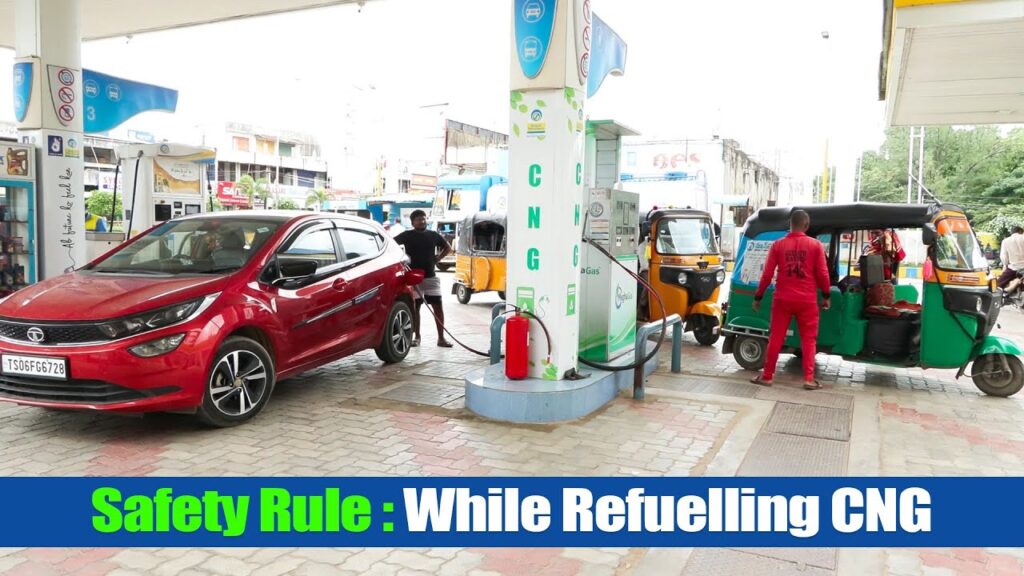
As CNG vehicles gain popularity across India for their cost-efficiency and environmental benefits, many drivers remain unaware of critical safety protocols during refueling. A common sight at CNG stations – attendants insisting all passengers exit the vehicle – often raises questions. This comprehensive guide explains the science behind this safety measure and other essential CNG refueling precautions.
With over 3.5 million CNG vehicles on Indian roads as of 2025, understanding these safety norms could prevent potential disasters. We’ll cover:
✔ Physics behind CNG refueling pressure dynamics
✔ Five life-saving reasons to exit your vehicle
✔ Step-by-step safe refueling procedure
✔ CNG maintenance best practices
✔ FAQs about CNG vehicle safety
CNG Refueling: Key Safety Facts
| Parameter | Petrol/Diesel | CNG |
|---|---|---|
| Refueling Pressure | Atmospheric | 200-250 bar |
| Storage Temperature | Ambient | -160°C (compressed) |
| Flammability Range | 1.4-7.6% | 5-15% |
| Ignition Temperature | 250-300°C | 540°C |
5 Critical Reasons to Exit Your CNG Vehicle During Refueling
1. Extreme Pressure Dynamics (200-250 Bar)
CNG refueling involves transferring gas at pressures 200 times greater than car tires. This creates:
- Structural stress on vehicle chassis
- Potential for micro-leaks in aging components
- Risk multiplier when combined with passenger weight
Safety Protocol: Emptying the vehicle reduces mechanical stress during this vulnerable phase.
2. Gas Leak Hazards
Unlike liquid fuels, CNG:
- Disperses rapidly when leaked
- Can accumulate in enclosed spaces
- Creates invisible explosion risk
Real Incident: 2023 Delhi case where static electricity ignited leaked CNG in occupied vehicle.
3. Meter Monitoring Requirements
CNG dispensers require:
- Clear view of pressure gauges
- Verification of automatic shut-off systems
- Immediate response to any irregular readings
Passengers obstruct these critical visual checks.
4. Health Risks from Gas Exposure
Prolonged CNG exposure may cause:
- Headaches (methane displacement of oxygen)
- Dizziness
- Nausea
- Eye irritation
5. Overfilling Prevention
The “full” signal requires:
- Audible confirmation
- Visual tank inspection
- Immediate nozzle removal
Passengers delay this time-sensitive response.
CNG Refueling: Step-by-Step Safety Protocol
- Park & Power Down
- Turn off engine
- Engage parking brake
- Switch off all electronics
- Passenger Evacuation
- All occupants exit vehicle
- Move to designated safe area
- Keep children supervised
- Attendant Coordination
- Present CNG authorization card
- Confirm correct nozzle connection
- Verify meter zeroing
- Active Monitoring
- Watch pressure gauge
- Listen for unusual sounds
- Note refueling duration (typically 2-5 mins)
- Post-Refueling Checks
- Inspect filler neck
- Check for hissing sounds
- Confirm tank shut-off valve
CNG Vehicle Maintenance Checklist
Ensure quarterly inspections of:
- High-pressure lines (cracks/abrasions)
- Fittings and connections (leak tests)
- Tank mounting brackets (corrosion)
- Emergency shut-off valve (functionality)
- Ventilation system (blockages)
Pro Tip: Apply soapy water to connections – bubbles indicate leaks.
FAQs About CNG Vehicle Safety
❓ Can I keep the AC running during CNG refueling?
🛑 Absolutely not – Electrical systems must be completely off to prevent sparks.
❓ How often should CNG tanks be replaced?
⏳ Every 15-20 years – Mandatory hydrostatic testing required every 5 years.
❓ Is smoking near CNG stations dangerous?
🔥 Extremely – CNG is odorless; leaks may not be detectable without added mercaptan.
❓ Why do CNG vehicles have different boot space?
📦 Newer two-cylinder technology (Tata, Hyundai) saves 30% more space than conventional toroidal tanks.
❓ What should I do if I smell gas?
🚨 Immediately:
- Evacuate all passengers
- Don’t start the engine
- Call emergency services
- Ventilate the area
The Future of CNG Technology
Automakers are developing:
- Composite tanks (lighter, more durable)
- Smart sensors (real-time leak detection)
- Enhanced ventilation systems
- Quick-connect nozzles (reducing refueling time)
Conclusion: Safety First With CNG
While CNG offers significant cost and environmental advantages, respecting its unique handling requirements ensures these benefits don’t come at the cost of safety. Remember:
✔ Always exit during refueling
✔ Follow attendant instructions
✔ Maintain regular inspections
✔ Educate all passengers
By making these practices habitual, India’s CNG revolution can continue safely and sustainably.
Have you experienced CNG refueling challenges? Share your thoughts below!
For official safety guidelines:
🔗 PNGRB CNG Safety Manual
🔗 MoRTH Vehicle Standards